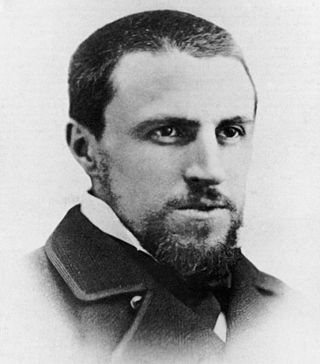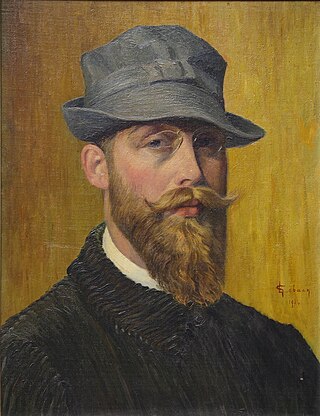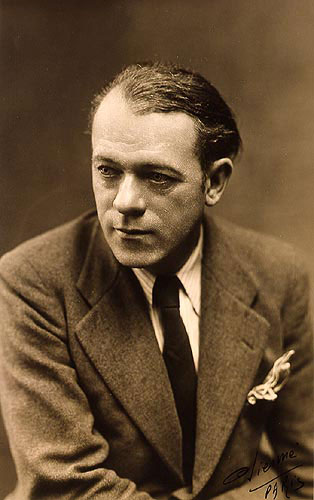
Gustave Caillebotte was a French painter who was a member and patron of the Impressionists, although he painted in a more realistic manner than many others in the group. Caillebotte was known for his early interest in photography as an art form.

Ivan Albertovich Puni was a Russian avant-garde artist.

The Cirque d'Hiver, located at 110 rue Amelot, has been a prominent venue for circuses, exhibitions of dressage, musical concerts, and other events, including exhibitions of Turkish wrestling and even fashion shows. The theatre was designed by the architect Jacques Ignace Hittorff and was opened by Emperor Napoleon III on 11 December 1852 as the Cirque Napoléon. The orchestral concerts of Jules Etienne Pasdeloup were inaugurated at the Cirque Napoléon on 27 October 1861 and continued for more than twenty years. The theatre was renamed Cirque d'Hiver in 1870.
Antonio Saura Atarés was a Spanish artist and writer, one of the major post-war painters to emerge in Spain in the fifties whose work has marked several generations of artists and whose critical voice is often remembered.

The Cirque Medrano is a French circus that was located at 63 Boulevard de Rochechouart, at the corner of rue des Martyrs, in the 18th arrondissement at the edge of Montmartre in Paris. It was originally called Cirque Fernando. The title "Cirque Medrano" is still active today: it is now a successful French traveling circus.

Georges-Émile Lebacq was a Belgian painter.
Pierre Tal-Coat was a French artist considered to be one of the founders of Tachisme.

Fauvism is the style of les Fauves, a group of early 20th-century modern artists whose works emphasized painterly qualities and strong colour over the representational or realistic values retained by Impressionism. While Fauvism as a style began around 1904 and continued beyond 1910, the movement as such lasted only a few years, 1905–1908, and had three exhibitions. The leaders of the movement were André Derain and Henri Matisse.

François Fiedler (1921–2001), born Fiedler Ferenc, was a Czechoslovakia-born French painter and printmaker. He was an artist in the Aimé Maeght stable, which included Marc Chagall, Alberto Giacometti and Joan Miró.

Jean Messagier was a French painter, sculptor, printmaker and poet. Jean Messagier had his first solo exhibition in Paris at Galerie Arc-en-Ciel in 1947. From 1945 to 1949 the artist worked under the influence of Pablo Picasso, André Masson, Paul Klee and François Desnoyer, his professor at École nationale supérieure des arts décoratifs in Paris. Messagier again was revealed to the public at an exhibition organized by Charles Estienne at the Galerie de Babylone in 1952, entitled "La Nouvelle École de Paris". The following year, Messagier deliberately broke away from his expressionistic form of Post-Cubism; his inspirations now focused on Jean Fautrier and Pierre Tal-Coat to develop a personal vision in which he renders "light...approached abstractly." Jean Messagier is often associated with Lyrical abstraction, Tachisme, Nuagisme, Art informel and paysagisme abstrait, though the artist himself had never accepted any labels, and had always refused the distinction between abstraction and figuration. From 1962 until the year of his death Jean Messagier exhibited in France and abroad, taking part in some major international events as a representative of new trends in French painting.

Jean Dufy was a French painter of Parisian society, country scenes, circuses, horse races, theatrical productions, and orchestras. His work was exhibited in museums and galleries throughout his career.

Albert Lebourg, birth name Albert-Marie Lebourg, also called Albert-Charles Lebourg and Charles Albert Lebourg, was a French Impressionist and Post-Impressionist landscape painter of the Rouen School. Member of the Société des Artistes Français, he actively worked in a luminous Impressionist style, creating more than 2,000 landscapes during his lifetime. The artist was represented by Galerie Mancini in Paris in 1896, in 1899 and 1910 by : Galerie Bernheim-Jeune, 1903 and 1906 at the Galerie Paul Rosenberg, and 1918 and 1923 at Galerie Georges Petit.

The Circus is an oil on canvas painting by Georges Seurat. It was his last painting, made in a Neo-Impressionist style in 1890–91, and remained unfinished at his death in March 1891. The painting is located at the Musée d'Orsay in Paris.

Le Chahut is a Neo-Impressionist painting by Georges Seurat, dated 1889–90. It was first exhibited at the 1890 Salon de la Société des Artistes Indépendants in Paris. Chahut became a target of art critics, and was widely discussed among Symbolist critics.

Parade de cirque is an 1887-88 Neo-Impressionist painting by Georges Seurat. It was first exhibited at the 1888 Salon de la Société des Artistes Indépendants in Paris, where it became one of Seurat's least admired works. Parade de cirque represents the sideshow of the Circus Corvi at place de la Nation, and was his first depiction of a nocturnal scene, and first painting of popular entertainment. Seurat worked on the theme for nearly six years before completing the final painting.
The Galerie Barbazanges was an art gallery in Paris that exhibited contemporary art between 1911 and 1928. The building was owned by a wealthy fashion designer, Paul Poiret, and the gallery was used for Poiret's "Salon d'Antin" exhibitions. The gallery showed the work of avant-garde artists such as Picasso, Modigliani, Gauguin, Matisse, Chagall, and Dufy.

Jean-Baptiste Olive was a French painter.

Le Grand Cirque is a 1968 oil on canvas painting by Belarusian-French artist Marc Chagall.

Scène De Cirque is an oil on canvas painting by Belarusian-French artist Marc Chagall.

Le Clown au Cirque is a tempera and pen and ink on board painting by Belarusian-French artist Marc Chagall created in 1980.

















